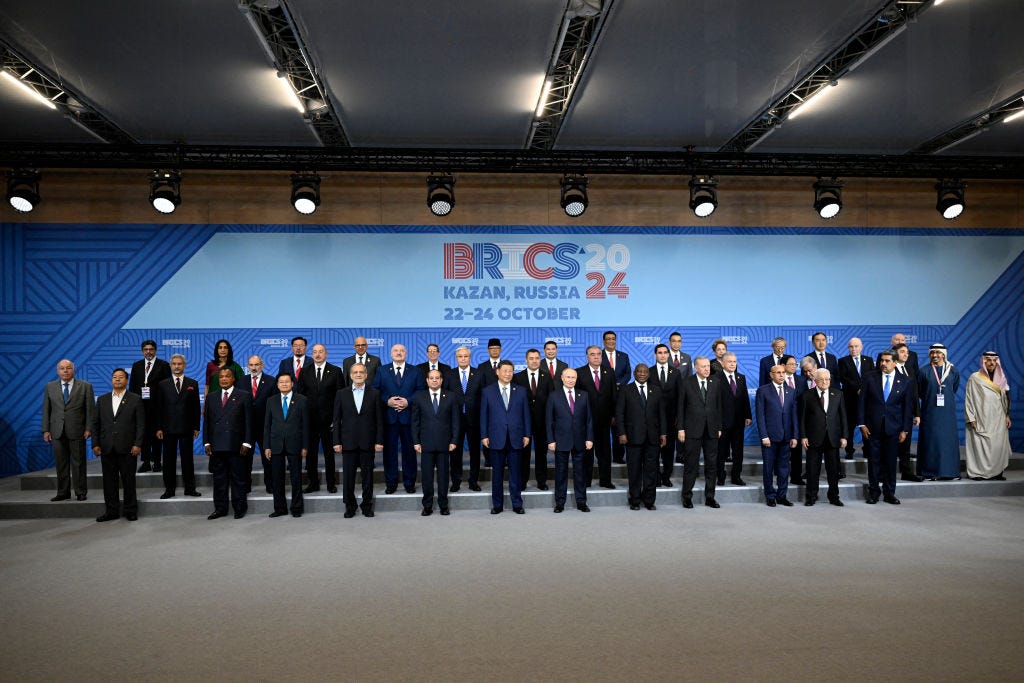Trick or Treat? Decoding Climate And Food Narratives
A look at some of the supposed solutions for our ailing climate and broken food systems
By now, most of us have seen harrowing, almost-post-apocalyptic images of Spain’s devastating floods. Cars piled on top of each other. Roads under water. Debris everywhere. Residents walking in knee-deep water, looking shell-shocked.
I really hope these images don’t become the norm, nor that we become desensitised to them, because chances are we’re going to see more in the near future. Autumnal storms are common in Spain but scientists are already saying the destructive weather system that brought about the floods is growing more frequent due to climate change.
Hours after the world was confronted with what’s happening in Spain, a new report from World Weather Attribution said more than half a million people have been killed by the 10 deadliest extreme weather events over the past two decades. Our addiction to fossil fuels and deforestation intensified these events, it said.
“Climate change isn’t a distant threat,” Dr Friederike Otto, Co-founder and Lead of World Weather Attribution, said in a press release.
How many more warnings must we hear before we do anything? How many more horrible images must we see before we change course?
Equally importantly, how many false solutions, silver bullets, and tricks must we chase after, before it’s too late?
Addendum from last week
First off, I have to remedy a major gap in my last issue, which focused on agriculture’s impact on European water and soils. I forgot to mention a new analysis from the World Resources Institute that looked at water issues on a global scale, especially how water scarcity is putting crops at risk. Here’s a quick rundown of the key findings:
25% of the world’s crops are grown in areas where the water supply is highly stressed, highly unreliable or both.
33% of rice, wheat and corn, which between them provide more than half the world’s food calories, are produced using water supplies that are highly stressed or highly variable.
Both rainfed and irrigated crops face mounting threats, the former from increased competition for water and the latter from erratic weather patterns.
Just 10 countries — China, India, United States, Pakistan, Brazil, Egypt, Mexico, Vietnam, Indonesia and Thailand — produce 72% of the world’s irrigated crops. Two-thirds of these crops face high to extremely high levels of water stress.
By 2050, nearly half of rainfed crops will face unreliable water supplies compared to only 8% in 2020.
Given this issue is coming out a day after Halloween, I thought it would be apt to look at some of the big debates around what’s needed to really rein in climate change and transform our food systems.
Biomethane
To talk about biomethane, we have to start with biogas, which the International Energy Agency describes as “a mixture of methane, CO₂ and small quantities of other gases produced by anaerobic digestion of organic matter in an oxygen-free environment”. Organic matter here includes crop residue, animal manure, and food waste. A vast majority of biogas today comes from crops and animal manure, leading to heated debates on the wisdom of diverting farmland and crops to produce fuel instead of food.
Biomethane, also known as renewable natural gas, is the purified version of biogas. According to the European Commission, it is “a sustainable alternative to fossil gas” that “can play a significant role towards achieving the EU’s clean energy objectives” and also “to further diversify the EU’s gas supplies, phasing out Europe’s dependency on Russian fossil fuels and reducing the exposure of consumers to volatile natural gas prices.”
But getting to that stage requires ramping up biomethane production 10-fold to reach 35 billion cubic metres annually by 2030. So is it really the solution we need?
Well, let’s first start with the misleading terminology. ‘Natural’ and ‘renewable’ make it sound like it’s green, but it’s just less problematic compared to coal or oil and we (humans and animals) will keep producing waste. Critics say these terms “greenwashes unhealthy and polluting agricultural practices.”
However, early research from the World Resources Institute found that biomethane can actually produce “meaningful greenhouse gas emissions benefits” when two basic conditions are met:
The gas is made from actual waste (as opposed to crops grown specifically for fuel, or diverted biomass that has other uses); and
Its production and use results in a net reduction in methane emissions.
But WRI also warned in 2020 that biomethane projects can end up doing more harm than good, especially because “methane itself is a greenhouse gas 84-86 times more powerful than carbon dioxide (on a 20-year timescale)”.
So things like methane leaks in the supply chain, building new fossil fuel-based infrastructure to produce it, or its production causing more greenhouse gas emissions could hurt global and local climate and environmental goals.
Last week, as the industry-sponsored European Biomethane Week got underway, Feedback EU, a food justice organisation based in The Hague, Netherlands, published a 32-page report ripping apart the Commission’s - and the industry’s - narrative.
The rush for biomethane will encourage more factory farms, that will in turn have negative consequences on animal welfare, rural diversity, biodiversity, and greenhouse gas emissions, said the report, titled “Biomethane From Manure: A Curse, Not A Cure”.
The industry is expecting livestock manure to contribute a third of total EU biomethane production by 2030, which means intensification of livestock production, at least in the short- to medium-term before other sources can catch up, it said.
“While biomethane production may reduce emissions from manure management, it fails to address the broader systemic emissions associated with livestock farming, such as those resulting from land use change, enteric fermentation, and transportation. Relying on anaerobic digestion from manure without broader mitigation measures is locking the EU into unsustainable, intensive livestock farming practices, which are deeply embedded in the EU’s current agricultural model. This ultimately hinders the transition to more sustainable food and agricultural systems.”
I have to say I find the criticism convincing. If, as the Commission itself admits, that biomethane production has to increase 10-fold to reach the production goal of 35 billion cubic metres a year, I don’t see where else said manure will come from besides having more livestock? It also seems to go against the scientific grain because there is broad consensus that some of us should be eating less meat.
Trick or Treat? Sounds like a trick.
Hope
“What if hope is the antidepressant that has been keeping us all comfortably numb when we have every right to be sad, worried, stirred to action or just plain angry?,” asked Jonathan Watt’s (necessarily) provocative piece in The Guardian this week, “Would abandoning false hope help us to tackle the climate crisis?”.
The story has been making the rounds among the food and climate circles, and no wonder! Because we get where he’s coming from.
You hear ever-desperate warnings from scientists that we’re heading towards the precipice and you see the misery and havoc wreaked by ever-worsening weather-related disasters. You then have to square that with mealy-mouthed reassurances from those in and with power that the next set of frameworks and commitments and resolutions will really do the trick, and the bold-faced lies and obfuscation from those who only have their own interests at heart.
No wonder many of us are furious and against hope.
Jonathan wrote that history has shown how “manufactured optimism can lead to complacency and the shirking of responsibilities”.
“In the 1990s, hope – coupled with doubt – was the fossil fuel industry’s antidote to the precautionary principle, the sensible idea that some problems had such dire implications that humanity should err on the side of caution even if the science was not completely settled. When George Bush was president, he was initially so concerned by the impact of fossil fuels on the climate that he looked into regulating the oil industry. But he backed away from this on the grounds that future generations would probably develop new technologies to solve the problem. Call that dumb, call that wishful thinking, or call that hope, the result was the same: no action.”
He also cited climate journalist Amy Westervelt who was stinging in her criticism of some of the “toxic positivity” on display at this year’s New York Climate Week.
She wrote of “an unsettling disconnect between people noshing on passed hors d'oeuvres and sipping craft cocktails while talking about the need to "stay positive!" "tell the positive stories!" "give people hope!" and the reality crashing in all around us, which this week included Hurricane Helene, a deadly storm and landslides in Nepal, a climate activist being sentenced to 2 years in prison in the UK for throwing soup on a painting, and, as always, more news of expanding fossil fuel development.”
So, is hope a false friend? I do believe what Jonathan and Amy are condemning isn’t hope per se, but hope-without-action, hope-sans-follow-up, hope-in lieu of-a spine. Here I’m going to quote Liko Smith-Doo, who, as a teenager, wrote this wonderful essay nearly three years ago, quoting Martin Luther King Jr. to argue that both hope and courage are necessary to solve climate change.
“When hope falters, the only options left are courage or collapse… Courage is not something you can spread as easily as hope, but once it is learned courage becomes a powerful force for good.”
Trick or Treat? False hope and fear are the mind killers. Hope with action can do something.
Make America Healthy Again (MAHA)
I covered this topic at length in a previous issue that focused on the U.S. Elections but since the polls - and a potential global cluster**** - are just days away and there have ben more insightful commentary, I thought it’s worth touching on it again.
At Food Fix, Helena Bottemiller Evich wrote about how both parties are scrambling behind the scenes to figure out how to respond to MAHA rhetoric and Robert F. Kennedy Jr.’s ascension within the Trump campaign.
On the surface, Kennedy’s criticism of Big Food, Big Ag, and Big Pharma and how America currently regulates food would be catnip for public health and food systems advocates. But Helena also gives us a reality check. “Trump’s track record as president was pretty much the opposite of everything he is now touting with (MAHA),” she wrote.
She listed all the things he - and his agencies - actually did while in power: relaxed school nutrition standards, reversed a ban on chlorpyrifos (a pesticide linked to neurological problems in children), little interest in cracking down on food chemicals, PFAS, or other “toxic chemicals” of concern, no moves to ban soda or processed foods under the federal anti-hunger programme, and no efforts to change farm subsidies to encourage fruit and vegetable production.
Errol Schweizer was saltier in his essay for The Checkout, calling MAHA’s link-up with Trump a “Faustian bargain” and listing a litany of things Trump did that go completely against the MAHA ethos.
He also pointed out how Project 2025 “proposes policies that could kneecap much of the MAHA agenda, including removing GMO labelling, weakening federal inspection requirements for meat processing, weakening the Endangered Species Act, and reducing the influence of EPA science on pesticide approvals”.
“MAHA is born of sincere concerns about the food system… But, a truly bipartisan movement would seek to build the broadest coalition and wield power to pressure whomever gets elected to do their bidding, instead of aligning with America’s most polarising politician, a protege of Roy Cohn and Vince McMahon, the son of a slumlord, a con man, a failed businessman, racist and misogynist, a failed Coup-ist with cognitive decline who has never done an honest day’s work. This is who MAHA thinks will disrupt the status quo?”
Trick or Treat? A treat-sounding trick.
BRICS As “Alternative World Order”
Unless you’ve been living under a rock, you would have seen that Russia last week hosted the splashy first summit of the expanded BRICS club of emerging economies.
In 2006, Brazil, Russia, India and China came together to form the BRICS group. It has since expanded to include South Africa, Iran, United Arab Emirates, Ethiopia, and Egypt. But this year’s summit was attended by nearly two dozen world leaders, which Putin will surely see - and portray - as a major win.
There’s a lot of hype around BRICS: that it is establishing a new and/or alternative world order to counter the old, Western colonial powers, especially America, and that its 32-page Kazan Declaration, unveiled a day before the Summit ended, is a manifesto for such change. But there is cause to be cautious when it comes to climate action.
At first glance, the declaration, which is long on words, seems very keen on climate action. After all, it mentioned “climate change” 22 times and reiterated its commitment to the Paris Agreement.
But Planet Critical’s Rachel Donald has taken a critical (ahem) look and pointed out the inconsistencies and double-speak, especially when it comes to transitioning away from fossil fuels, which pretty much every scientist worth their salt has said we need to do. Perhaps the most egregious sentence is this one on Page 22 of the declaration:
“We believe that the efficient use of all energy sources is critical for just energy transitions towards more flexible, resilient and sustainable energy systems and in this regard we uphold the principle of technological neutrality, i.e. using all available fuels, energy sources and technologies to reduce greenhouse gas emissions which includes, but is not limited to fossil fuels with abatement and removal technologies, biofuels, natural gas and LPG, hydrogen and its derivatives, including ammonia, nuclear and renewable power, etc.”
Rachel called this position “alarming”.
“Natural gas - methane gas - is a fossil fuel primarily used for heating and which studies have shown to pollute more emissions than coal, yet adding it in addition to “fossil fuels with abatement and removal technologies” suggests that BRICS is attempting both to position natural gas as a transition fuel (following in the footsteps of the Western hegemony they’re so desperate to leave behind) and that its use will not fall under the same mandate of deploying “removal technologies” to mitigate its emissions,” she wrote.
All this is pretty damning (we’ve also come full circle on the biogas/biomethane topic at the top), but I do wonder if perhaps the continued march of renewables will ultimately force them to change tack. I sincerely hope so.
After all, a new brief by the Global Energy Monitor said the share of fossil fuel-driven power capacity in the BRICS “could fall below 50%” for the first time ever by the end of this year. “Wind and utility-scale solar capacity in development outnumber power projects fuelled by coal, oil, and gas by two to one in the BRICS,” it added.
It’s not all good news though: BRICS countries, which represent half of the world’s population, continue to build additional coal, oil, or gas plants.
Trick or Treat? Jury is still out but they lose major points for (1) trying to pass off some of the worst authoritarianism we are seeing as revolutionary underdogs, (2) putting national sovereignty ahead of humanity in general, and (3) the utter lack of gender diversity. More trick-y than treat-y at this point.

Thin’s Pickings
A toxic relationship: ultra-processed foods & plastics - Globalisation and Health Journal
Are we ingesting highly hazardous chemicals through the plastic packaging that are so prevalent for ultra-processed foods? That in addition to little - or no - nutrients, UPFs may also be harmful because of what they come in? A commentary from international researchers trying to kick-start this conversation, by drawing attention to “this co-dependent duo generates substantial profits for agri-food and petrochemical industries at high costs for people and planet”.
Despite concerns, “thousands of chemicals migrating from plastic FCMs into food have not been comprehensively tested, thus their hazard properties and potential health effects are unknown”. This is partly due to a lack of transparency, “because food and plastics industries are not obliged to share, and seldom disclose, information about the chemical constituents of their plastic products, even within their supply chains”.
Comment: It’s time to end the UN’s artificial divide between biodiversity and climate - Climate Home News
Three civil society activists call governments to stop thinking and negotiating in silos on the “interlinked crises” of climate and biodiversity.
“The most fundamental failure appears to be that neither Convention fully recognises that we cannot solve the climate crisis unless we solve the biodiversity crisis at the same time; and that keeping ecosystem carbon out of the atmosphere is dependent on doing two things simultaneously: reducing fossil fuel emissions, and reducing loss and damage to carbon-dense ecosystems and the biodiversity that underpins them.”
Why Farmers Use Harmful Insecticides They May Not Need - Civil Eats
“While the agrichemical industry claims farmers “carefully select the right pesticide for each pest and crop at issue” and “only use pesticides as a last resort,” when it comes to neonics, that is false in most cases. Nearly all commodity corn farmers receive seed coated with neonics at the start of each season; many cannot identify the chemical that’s in the coating and don’t even know if another option exists,” wrote Lisa Held in this important piece.
As always, please feel free to share this post and send tips and thoughts on bluesky @thinink.bsky.social, mastodon @ThinInk@journa.host, my LinkedIn page, twitter @thinink, or via e-mail thin@thin-ink.net.







Thanks for drawing my attention to the two articles on over-hyped hope. I was brought up in a tradition that distinguishes two forms of hope.
One is a virtue that keeps you going even when it is all against you. You don't need to see the light at the end of the tunnel, to hope for that light.
The other is perhaps closer to "optimism" or the endless pointing to the good things happening, any the hope only exists because people can see those good things. I kind of assume that this is because people are too frightened to fall into a place where things aren't looking good, fearing that they would lose hope. By contrast the first kind of hope is very deeply rooted in trusting that things will work out and, of course, doing the work to make sure that happens!